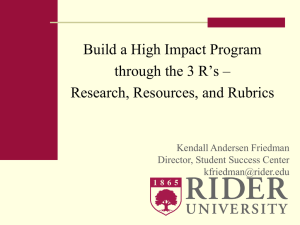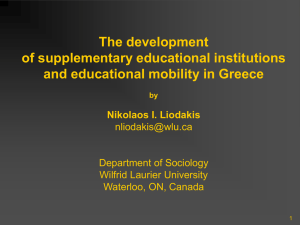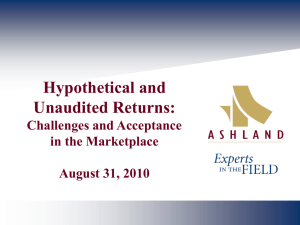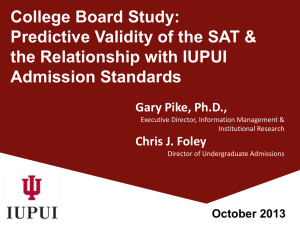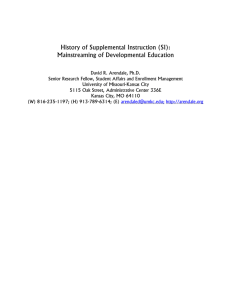Factors Influencing Student Usage of Supplemental Instruction
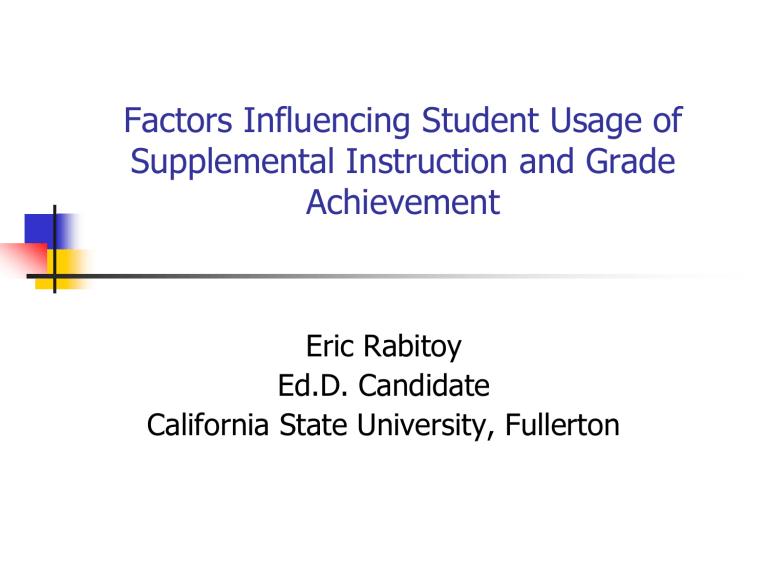
Factors Influencing Student Usage of
Supplemental Instruction and Grade
Achievement
Eric Rabitoy
Ed.D. Candidate
California State University, Fullerton
Topic Background
Supplemental Instruction (SI)
Initiated by Deanna Martin at the
University of Missouri, Kansas City
(Martin,
1980)
Provides support for students enrolled in high-risk courses
Intent of SI
Topic Background
SI Pedagogy
Relies on regular out-of-class group interactions focused on integrating reasoning and study skills
(Arendale, 2004; Van
Lanen & Lockie, 1997)
Topic Background
SI Pedagogy
Open to all enrolled students
Students work with the SI leader in small groups to discuss course content and learn to integrate effective skills
(Arendale, 1994; Congos,
2002)
Participating students take an active role
Impact of SI
Studies suggest that students participating in SI benefit in a number of ways over non-participants:
final course grades (Commander, Stratton, Callahan & Smith, 1996;
Fayowski & McMillan, 2008; Moore & LeDee, 2006) cumulative GPA (Fayowski & McMillan, 2008) graduation rates (Arendale, 1998; Bowles, McCoy & Bates, 2008)
SI Environment
Student populations are diverse
Ethnicity, academic preparation, gender
SI environment is diverse
# SI sessions attended, gender/ethnicity of SI leader, gender/ethnicity of course instructor
Each of these variables may have an impact on final course grade and cumulative GPA
Research Study
This study evaluated the effect of these multiple independent variables on one another, as well as on final course grade and cumulative GPA, for community college students enrolled in math and science courses
Theoretical Framework
Input – Environment – Outcome College
Impact Model
(Astin, 1993)
Input – characteristics students possess upon entrance to college
Environment – programs, people, and cultures that students experience as a result of their participation in college
Outcome – skills, knowledge, values, and beliefs that students obtain as a result of their college experience.
Theoretical Framework
Input
Student of Color
Student Gender
Prior GPA
English P. S.
Math P. S.
Environment
SI Leader Student of Color
Gender SI Leader
Gender Course Instructor
Course Instructor Faculty of Color
Outcome
# SI Sessions Attended
Course GPA
Cumulative GPA
Data Collection
Data originated with student and faculty participation in an SI program in STEMrelated disciplines at a single community college campus district in Southern California
Spring 2009, fall 2009, winter 2010, and spring
2010 semesters (N = 3,443)
Research Design: Data
Analysis
Data analysis relied upon a multivariate path analytic approach (AMOS)
account for the simultaneous influence of multiple variables acting together within a model
(Ewert & Sibthorp, 2000)
determine the influence of individual variables on overall effect
(Graham, 2007)
Research Design: Data
Analysis
Structural Equation Modeling (SEM) enables researchers to develop, estimate, and evaluate complex multivariate models and study both direct and indirect effects associated with variables
Causal relationships between variables are depicted with arrows; indicating the influence of one variable on another
(Ewert & Sibthorp, 2000)
The resulting diagram consists of a series of paths that indicate the effect of one variable on another within a model
(Raykov & Marcoulides, 2006)
Results – General Model
Large Effect Size*
Medium Effect Size*
Small Effect Size*
* (Cohen, 1988)
X 2 = 1,715.74, df = 31, N = 3,443 p < .001
Females
Results - Gender
Males
X 2 = 983.759, df = 25, N = 1,956, p < .001
X 2 = 634.437, df = 28, N = 1,424, p < .001
SOC
Results – SOC Status
White students
X 2 = 740.848, df = 26, N = 1,659, p < .001
X 2 = 385.860, df = 8, N = 768, p < .001
References
Arendale, D. (1994). Understanding the supplemental instruction model. In D. C.
Martin, & D. R. Arendale (Eds.),
21. San Francisco: Jossey-Bass.
Supplemental instruction: Increasing achievement and retention. New Directions for Teaching and Learning, (60 ), 11-
Arendale, D. (1998). Increasing efficiency and effectiveness of learning for freshmen students through Supplemental Instruction. In P. Dwinell, & J. S.
Higbee (Eds.). The role of developmental education in preparing successful college students . Columbia, SC.: The National Association for Developmental
Education and the National Center for the Study of the First Year Experience and
Students in Transition.
Arendale, D. (2004). Pathways of persistence: A review of postsecondary peer cooperative learning programs. In I. M. Duranczyk, J. L. Higbee, & D. B. Lundell
(Eds.), Best practices for access and retention in higher education
Literacy, General College, University of Minnesota.
. (pp. 27-40).
Minneapolis, MN: Center for Research on Developmental Education and Urban
Astin, A. W. (1993). What matters in college? Four critical years revisited
Franscisco: Jossey-Bass.
. San
References
Bowles, T., McCoy, A., & Bates, S. (2008). The effect of Supplemental Instruction on timely graduation. College Student Journal , 42 ( 3 ), 853-859.
Cohen, J. (1980). Statistical power and analysis for the behavioral sciences ed.). Hillsdale, NJ: Lawrence Erlbaum Associates.
(2 nd
Commander, N. F., Stratton, C. B., Callahan, C. A., & Smith, B. D. (1996). A learning assistance model for expanding academic support. Journal of
Developmental Education . 20 (2), 8-16.
Congos, D. (2002). How supplemental instruction stacks up against Chickering’s 7 principles for good practice in undergraduate education. Research & Teaching in Developmental Education, 19 (1), 75-83.
Ewert, A., & Sibthorp, J. (2000). Multivariate analysis in experiential education:
Exploring the possibilities.
117.
The Journal of Experiential Education, 23 (2), 108-
References
Fayowski, V., & MacMillan, P. (2008). An evaluation of the Supplemental Instruction programme in a first year calculus course. International Journal of Mathematical
Education in Science & Technology , 39 (7), 843-855.
Graham, J. (2007). The general linear model as structural equation modeling.
Journal of Educational and Behavioral Statistics, 33 (4), 485-506.
Martin, D. C. (1980). Learning centers in professional schools. In K. V. Lauridsen
Ed.), New directions for college learning assistance: Examining the scope of learning centers (pp. 69-79). San Francisco: Jossey-Bass.
Moore, R., & LeDee, O. (2006). Supplemental Instruction and the performance of developmental education students in an introductory biology course. Journal of
College Reading and Learning, 38 (2), 9-20.
Raykov, T., & Marcoulides, G. (2006 ). A first course in structural equation modeling
(2nd ed.). New York: Psychology Press.
Van Lanen, R. J., & Lockie, N. (1997). Using Supplemental Instruction to assist nursing students in chemistry.
423.
Journal of College Science Teaching , 26 (6), 419-

